
S&P 500
Upwards movement has continued all week exactly as expected.
Price has reached the target and exceeded it by 2.47 points, but the Elliott wave structure is incomplete. A new target is calculated.
Summary: The target for intermediate wave (1) to end is now at 2,687. The target may be met next week.
A classic analysis target using Friday’s gap open is at 2,722.
The bigger picture still expects that a low may now be in place. Further confidence in this view may be had now that price has made new high above 2,631.09. The target is at 3,045 with a limit at 3,477.39. The Elliott wave count has support classic technical analysis.
The biggest picture, Grand Super Cycle analysis, is here.
The monthly chart was last published here.
ELLIOTT WAVE COUNT
WEEKLY CHART
This weekly chart shows all of cycle waves III, IV and V so far.
Cycle wave II fits as a time consuming double combination: flat – X – zigzag. Combinations tend to be more time consuming corrective structures than zigzags. Cycle wave IV has completed as a multiple zigzag that should be expected to be more brief than cycle wave II.
Cycle wave IV may have ended at the lower edge of the Elliott channel.
Within cycle wave V, no second wave correction may move beyond the start of its first wave below 2,346.58.
Although both cycle waves II and IV are labelled W-X-Y, they are different corrective structures. There are two broad groups of Elliott wave corrective structures: the zigzag family, which are sharp corrections, and all the rest, which are sideways corrections. Multiple zigzags belong to the zigzag family and combinations belong to the sideways family. There is perfect alternation between the possible double zigzag of cycle wave IV and the combination of cycle wave II.
Although there is gross disproportion between the duration of cycle waves II and IV, the size of cycle wave IV in terms of price makes these two corrections look like they should be labelled at the same degree. Proportion is a function of either or both of price and time.
Draw the Elliott channel about Super Cycle wave (V) with the first trend line from the end of cycle wave I (at 2,079.46 on the week beginning 30th November 2014) to the high of cycle wave III, then place a parallel copy on the low of cycle wave II. Cycle wave V may find resistance about the upper edge.
DAILY CHART
The daily chart will focus on the structure of cycle waves IV and V.
Cycle wave IV may be a complete double zigzag. This would provide perfect alternation with the combination of cycle wave II. Double zigzags are fairly common corrective structures.
Within Super Cycle wave (V), cycle wave III may not be the shortest actionary wave. Because cycle wave III is shorter than cycle wave I, this limits cycle wave V to no longer than equality in length with cycle wave III at 3,477.39. A target is calculated for cycle wave V to end prior to this point.
Cycle wave V must subdivide as a five wave motive structure, either an impulse or an ending diagonal. An impulse is much more common and that will be how it is labelled. A diagonal would be considered if overlapping suggests it.
Within the five wave structure for cycle wave V, primary wave 1 would be incomplete. Within primary wave 1, intermediate wave (1) may be incomplete. The degree of labelling within cycle wave V may need to be adjusted as it unfolds further. At this stage, an adjustment may be to move the degree of labelling within cycle wave V up one degree; it is possible that it could be primary wave 1 now close to completion.
Within cycle wave V, no second wave correction may move beyond the start of its first wave below 2,346.58.
There is more than one way to label the unfolding impulse of intermediate wave (1). If this labelling is correct, then within this impulse minor wave 3 is shorter than minor wave 1. This limits minor wave 5 to no longer than equality with minor wave 3 at 2,731.32, so that minor wave 3 is not the shortest actionary wave and this core Elliott wave rule is met.
However, it is also possible to see minor wave 3 incomplete. Because there is an alternate way to label this impulse the limit at 2,731.32 may be passed and the wave count would remain valid.
TECHNICAL ANALYSIS
WEEKLY CHART
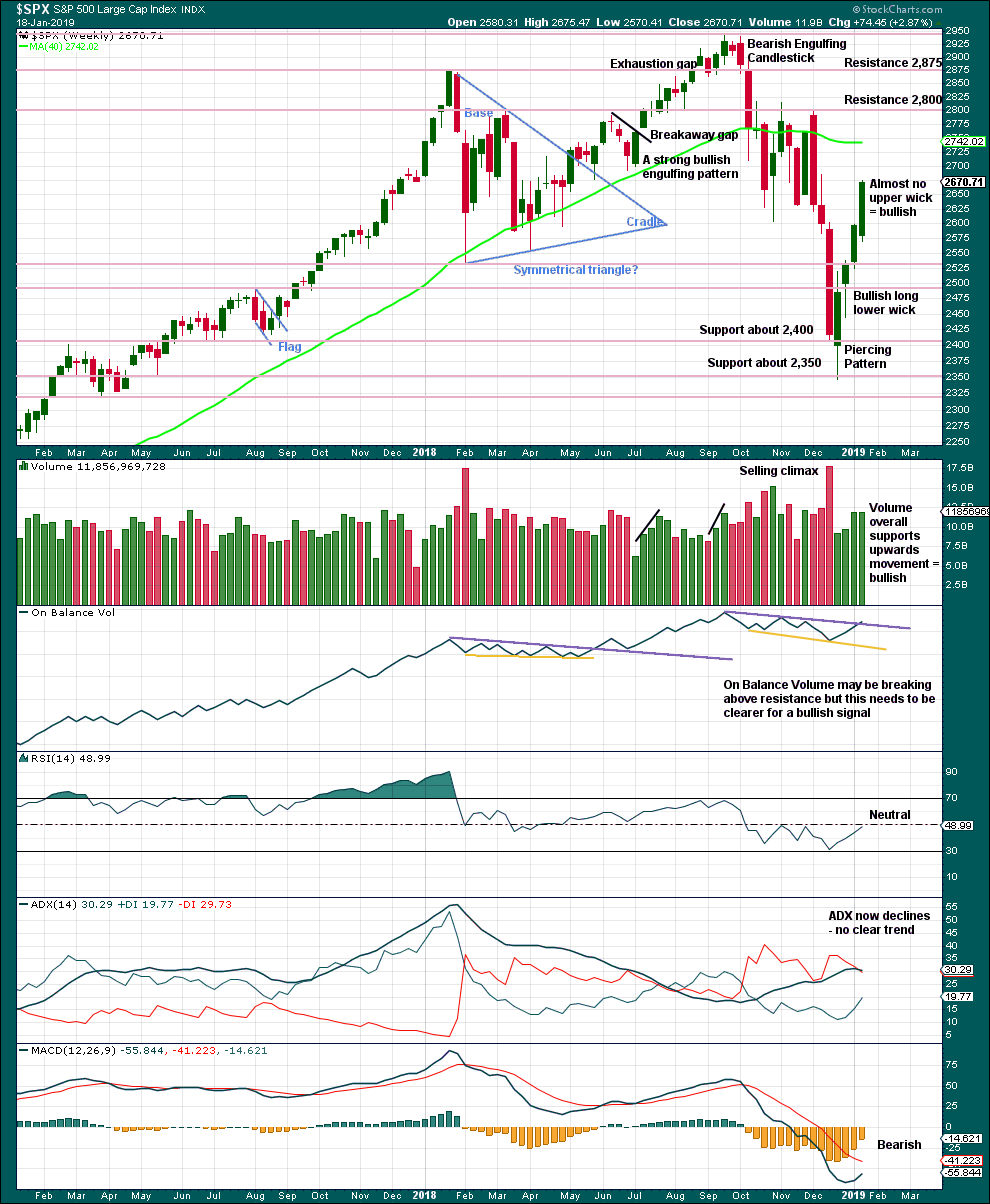
Click chart to enlarge. Chart courtesy of StockCharts.com.
From the all time high to the low of last week, price moved lower by 20.2% of market value meeting the definition for a bear market.
It should be noted that the large fall in price from May 2011 to October 2011 also met this definition of a bear market, yet it was only a very large pullback within a bull market, which so far has lasted almost 10 years.
Again, this weekly candlestick has almost no upper wick. With price closing almost at the high for the week, it looks reasonable to expect more upwards movement next week.
This week volume has very slightly declined from last week. The decline is so slight, this will not be read as bearish.
DAILY CHART

Click chart to enlarge. Chart courtesy of StockCharts.com.
Over a fairly long period of time this ageing bull market has been characterised by upwards movement on light and declining volume and low ATR. For the short to mid term, little concern may be had if price now rises again on declining volume. Current market conditions have allowed for this during a sustained rise in price.
It is also normal for this market to have lower ATR during bullish phases, and strongly increasing ATR during bearish phases. Currently, declining ATR is normal and not of a concern.
Considering the larger picture from the Elliott wave count, some weakness approaching the end of Grand Super Cycle wave I is to be expected.
From Kirkpatrick and Dhalquist, “Technical Analysis” page 152:
“A 90% downside day occurs when on a particular day, the percentage of downside volume exceeds the total of upside and downside volume by 90% and the percentage of downside points exceeds the total of gained points and lost points by 90%. A 90% upside day occurs when both the upside volume and points gained are 90% of their respective totals”…
and “A major reversal is singled when an NPDD is followed by a 90% upside day or two 80% upside days back-to-back”.
The current situation saw two 80% downside days on December 20th and 21st, then a near 90% downside day with 88.97% downside on December 24th. This very heavy selling pressure on three sessions very close together may be sufficient to exhibit the pressure observed in a 90% downside day.
This has now been followed by two 90% upside days: on December 26th and again on 4th January.
The current situation looks very much like a major low has been found.
With volume now supporting rising price, it looks reasonable to expect more upwards movement next week. If a bearish candlestick reversal pattern prints on the daily chart, then a deeper pullback for a second wave may be expected.
The gap open for Friday’s session may be used to calculate a target. Measuring gaps are often halfway within a movement. A target may be at 2,722.
BREADTH – AD LINE
WEEKLY CHART
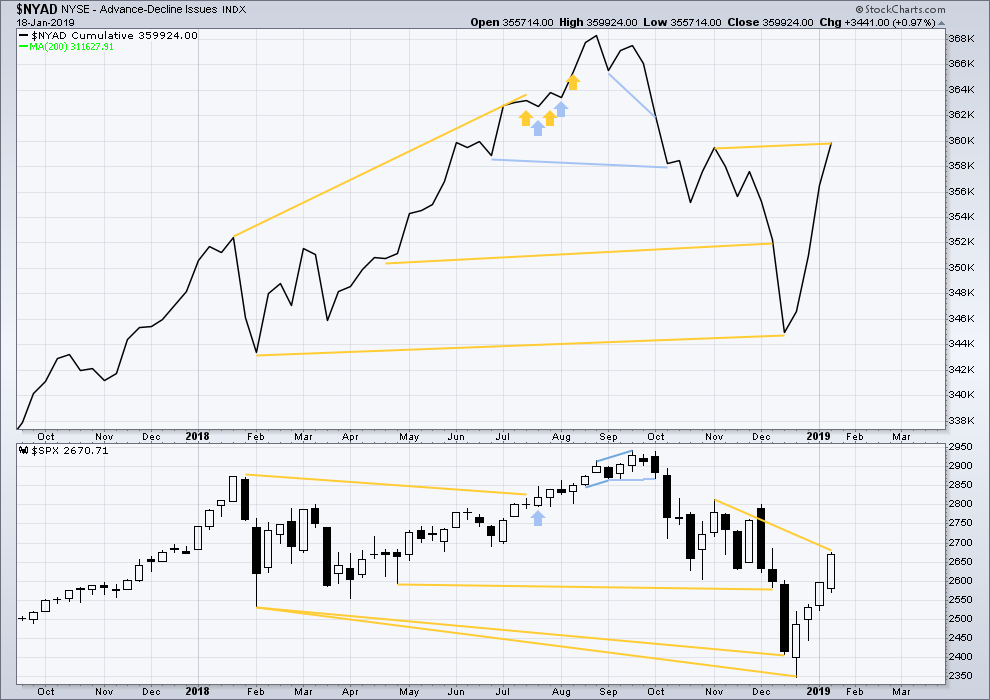
Click chart to enlarge. Chart courtesy of StockCharts.com. So that colour blind members are included, bearish signals
will be noted with blue and bullish signals with yellow.
This week the AD line has made a new high above the prior swing high of the week beginning 5th of November 2018, but price has not. This divergence is bullish for the mid term.
DAILY CHART
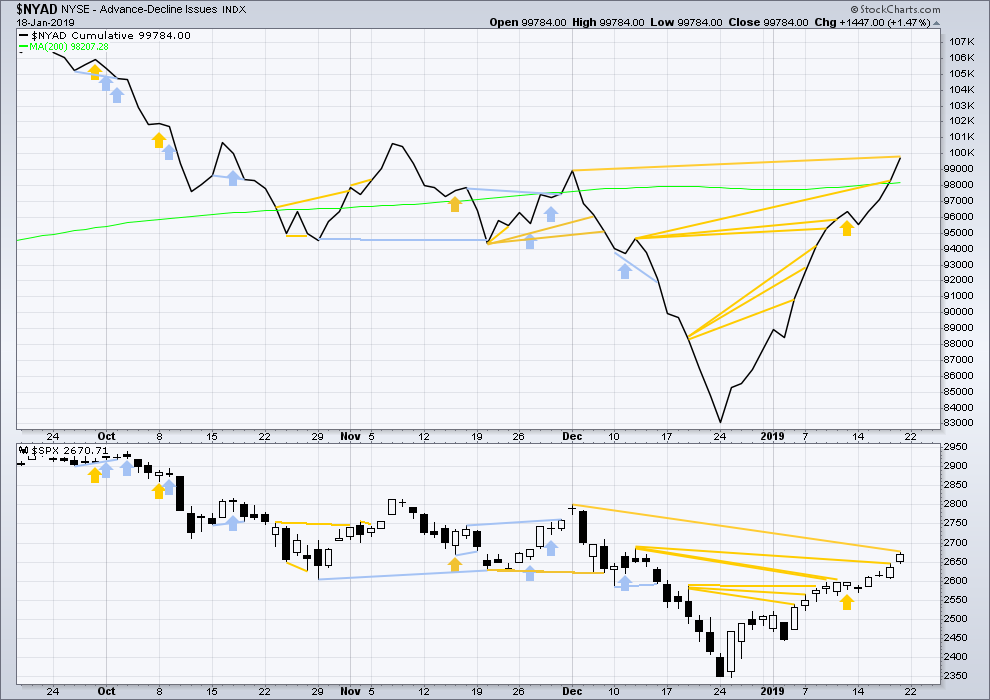
Click chart to enlarge. Chart courtesy of StockCharts.com. So that colour blind members are included, bearish signals
will be noted with blue and bullish signals with yellow.
Breadth should be read as a leading indicator.
There is now a cluster of bullish signals from the AD line. This supports the main Elliott wave count.
Today the AD line has made a new swing high above the prior high of the 3rd of December 2018, but price has not. This divergence is bullish for the mid term.
VOLATILITY – INVERTED VIX CHART
WEEKLY CHART

Click chart to enlarge. Chart courtesy of StockCharts.com. So that colour blind members are included, bearish signals
will be noted with blue and bullish signals with yellow.
This week inverted VIX has made a slight new high above the prior swing high of the weeks beginning 26th of November and 3rd of December 2018, but price has not. This divergence is bullish for the mid term.
DAILY CHART

Click chart to enlarge. Chart courtesy of StockCharts.com. So that colour blind members are included, bearish signals
will be noted with blue and bullish signals with yellow.
There is now a cluster of bullish signals from inverted VIX. This supports the main Elliott wave count.
Inverted VIX continues to make new highs above the prior swing high of the 12th / 13th of December 2018, but price has not. This divergence is bullish.
DOW THEORY
Dow Theory confirms a bear market. This does not necessarily mean a bear market at Grand Super Cycle degree though; Dow Theory makes no comment on Elliott wave counts. On the 25th of August 2015 Dow Theory also confirmed a bear market. The Elliott wave count sees that as part of cycle wave II. After Dow Theory confirmation of a bear market in August 2015, price went on to make new all time highs and the bull market continued.
DJIA: 23,344.52 – a close on the 19th of December at 23,284.97 confirms a bear market.
DJT: 9,806.79 – price has closed below this point on the 13th of December.
S&P500: 2,532.69 – a close on the 19th of December at 2,506.96 provides support to a bear market conclusion.
Nasdaq: 6,630.67 – a close on the 19th of December at 6,618.86 provides support to a bear market conclusion.
GOLD
A downwards day remains within the consolidation zone.
The Elliott wave count remains valid.
Summary: A sideways consolidation is now expected for a fourth wave to end next week. It may be very shallow, with support about 1,277 and resistance about 1,297. The breakout is expected to be upwards, and the resulting movement may be surprisingly short and brief.
Grand SuperCycle analysis is here.
Last historic analysis with monthly charts is here.
Only two remaining wave counts have a reasonable probability and are published below: a triangle (the preferred wave count) and a double zigzag.
MAIN ELLIOTT WAVE COUNT
WEEKLY CHART – TRIANGLE
Cycle wave b may be an incomplete regular contracting triangle. Primary wave E may not move beyond the end of primary wave C above 1,365.68.
Within primary wave E, intermediate waves (A) and (B) may be complete. Intermediate wave (C) must subdivide as a five wave structure. Within intermediate wave (C), minor wave 4 may not move into minor wave 1 price territory below 1,241.88.
Four of the five sub-waves of a triangle must be zigzags, with only one sub-wave allowed to be a multiple zigzag. Wave C is the most common sub-wave to subdivide as a multiple, and this is how primary wave C for this example fits best. Primary wave E looks like it is unfolding as a single zigzag.
There are no problems in terms of subdivisions or rare structures for this wave count. It has an excellent fit and so far a typical look.
When primary wave E is a complete three wave structure, then this wave count would expect a cycle degree trend change. Cycle wave c would most likely make new lows below the end of cycle wave a at 1,046.27 to avoid a truncation.
It is possible now that primary wave E may end in January or February 2019. Some reasonable weakness should be expected at its end. Triangles often end with declining ATR, weak momentum and weak volume.
DAILY CHART – TRIANGLE
Primary wave E may now be nearing its final stages for this wave count.
Primary wave E should subdivide as a zigzag. Intermediate waves (A) and (B) may now be complete. Intermediate wave (C) may now be nearing completion.
Minor wave 2 is a deep 0.75 zigzag. Minor wave 4 may be expected to most likely be a shallow sideways flat, triangle or combination. Minor wave 4 at this time looks most likely to be a triangle; but note that if it is not a triangle, then it could morph into a combination or zigzag.
Minor wave 3 exhibits the most common Fibonacci ratio to minor wave 1.
Minor wave 4 may not move into minor wave 1 price territory below 1,241.88.
A target for primary wave E is the strong zone of resistance about 1,305 to 1,310. Primary wave E may not move beyond the end of primary wave C above 1,365.68.
When minor wave 4 may be complete, then the target may be calculated at minor degree.
WEEKLY CHART – DOUBLE ZIGZAG
It is possible that cycle wave b may be a double zigzag or a double combination.
The first zigzag in the double is labelled primary wave W. This has a good fit.
The double may be joined by a corrective structure in the opposite direction, a triangle labelled primary wave X. The triangle would be about three quarters complete.
Within the triangle of primary wave X, intermediate wave (C) should be complete. Within intermediate wave (D), minor waves A and B may be complete. Minor wave C must subdivide as a five wave structure. Within minor wave C, minute wave iv may not move into minute wave i price territory below 1,241.88.
Intermediate wave (D) would most likely subdivide as a single zigzag.
This wave count may now expect choppy overlapping movement in an ever decreasing range for a few more months.
Primary wave Y would most likely be a zigzag because primary wave X would be shallow; double zigzags normally have relatively shallow X waves.
Primary wave Y may also be a flat correction if cycle wave b is a double combination, but combinations normally have deep X waves. This would be less likely.
This wave count has good proportions and no problems in terms of subdivisions.
TECHNICAL ANALYSIS
WEEKLY CHART

Click chart to enlarge. Chart courtesy of StockCharts.com.
ADX indicates a potential trend change to upwards, but as yet it does not indicate a new trend at this time frame.
This week completes an inside week with the balance of volume downwards and the candlestick closing red. Downwards movement within the week has some support from volume.
DAILY CHART
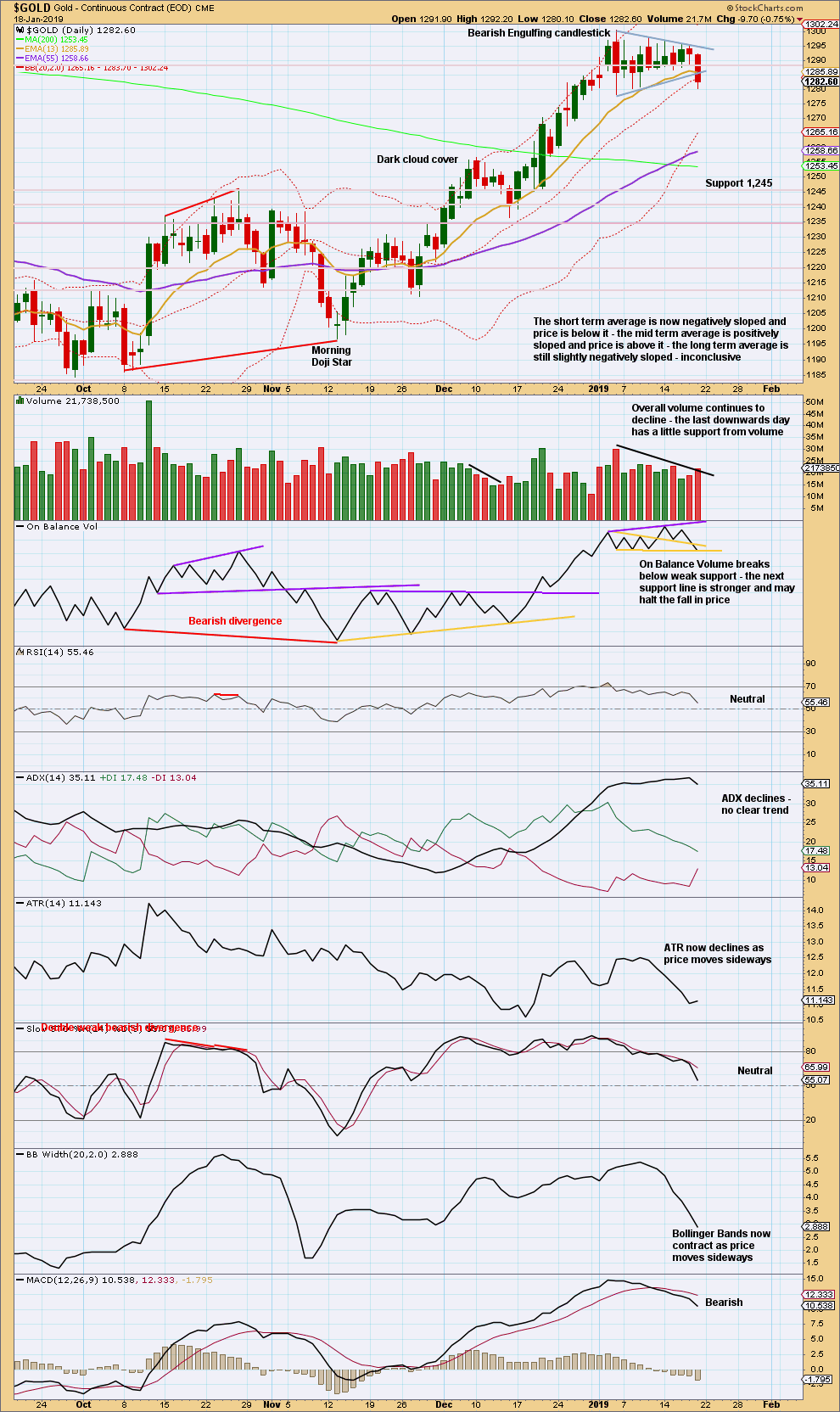
Click chart to enlarge. Chart courtesy of StockCharts.com.
The pennant pattern has failed. Friday was a downwards breakout below a very short-term support line, with a little support from volume. For this possible downwards breakout from the consolidation a new low below the lower edge of the consolidation zone at 1,278 would be required. That has not happened yet; price remains contained within resistance and support.
GDX WEEKLY CHART
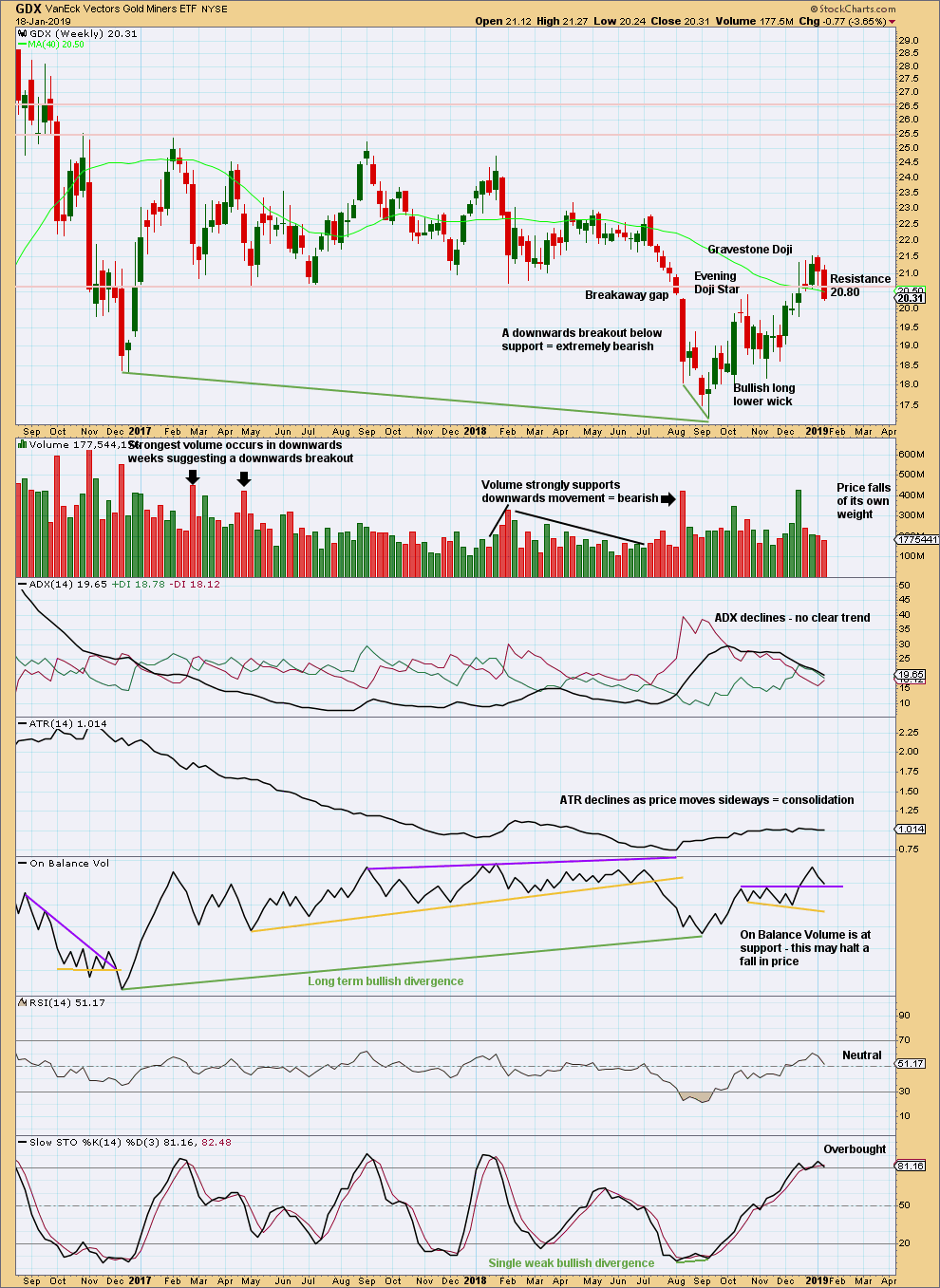
Click chart to enlarge. Chart courtesy of StockCharts.com.
Another breakout below 20.80 is very bearish. GDX may be now ready for another strong fall in price.
GDX DAILY CHART
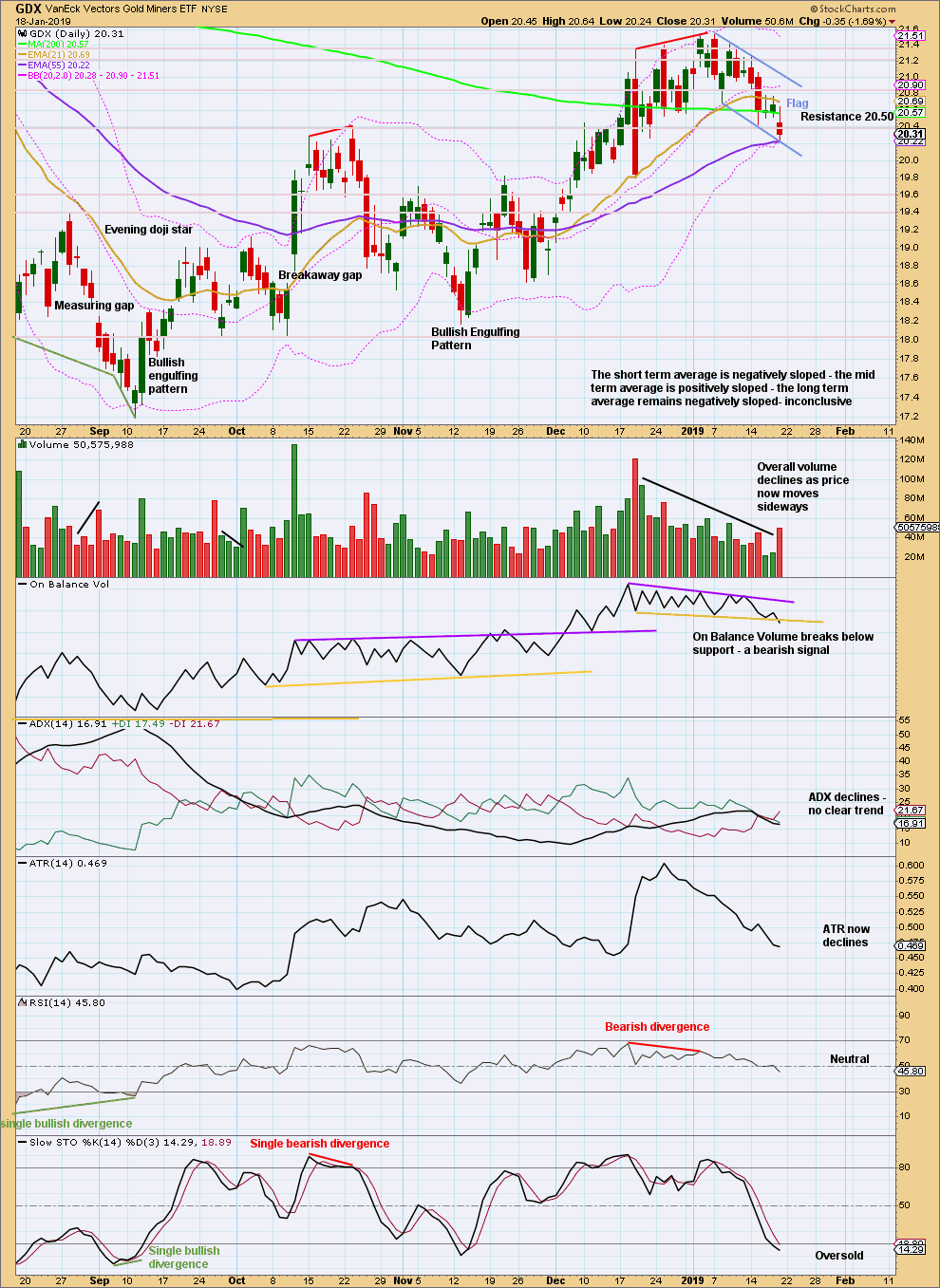
Click chart to enlarge. Chart courtesy of StockCharts.com.
The flag pattern remains valid for GDX, which has lasted now 10 sessions. The best flags and pennants complete within 15 sessions.
Flags are continuation patterns. An upwards breakout would be expected. The target would be about 22.60.
US OIL
For this last week a bounce was expected to continue. This is exactly what has happened. The final target remains the same and has not yet been met.
Summary: A bounce is expected to continue. A short-term target is at 55.02 to 55.56. At this target a pullback or sideways consolidation may be expected.
The final target for the bounce to end is about 63.71.
The larger picture still sees Oil in a new downwards trend to end reasonably below 26.06.
MAIN ELLIOTT WAVE COUNT
MONTHLY CHART
Classic technical analysis favours a bearish wave count for Oil at this time.
The large fall in price from the high in June 2008 to February 2016 is seen as a complete three wave structure. This large zigzag may have been only the first zigzag in a deeper double zigzag.
The first zigzag down is labelled cycle wave w. The double is joined by a now complete three in the opposite direction, a zigzag labelled cycle wave x.
The purpose of a second zigzag in a double is to deepen the correction when the first zigzag does not move price deep enough. Cycle wave y would be expected to move reasonably below the end of cycle wave w to deepen the correction. Were cycle wave y to reach equality with cycle wave w that takes Oil into negative price territory, which is not possible. Cycle wave y would reach 0.618 the length of cycle wave w at $2.33.
A better target calculation would be using the Fibonacci ratios between primary waves A and C within cycle wave y. This cannot be done until both primary waves A and B are complete.
Within cycle wave y, no second wave correction nor B wave may move beyond its start above 76.90.
WEEKLY CHART
This weekly chart is focussed on the start of cycle wave y.
Cycle wave y is expected to subdivide as a zigzag. A zigzag subdivides 5-3-5. Primary wave A must subdivide as a five wave structure if this wave count is correct.
Within primary wave A, intermediate wave (1) may now be complete. Intermediate wave (2) may unfold over a few weeks as a sideways choppy consolidation, or a deep sharp bounce. At this stage, it looks more likely to be a deep bounce.
Intermediate wave (2) may not move beyond the start of intermediate wave (1) above 76.90.
DAILY CHART
Intermediate wave (2) would most likely subdivide as a zigzag and at this stage that is how it will be labelled. However, it may also subdivide as a flat or combination. It is impossible at this stage to know which structure it will unfold as. The labelling within it may change as it unfolds.
If intermediate wave (2) is unfolding as a zigzag, then within it minor wave A must subdivide as a five wave structure. Within minor wave A, minute waves i to iv may now be complete. Minute wave v may be very near to completion.
A channel is drawn about minor wave A. If this channel is breached by downwards movement, that may be taken as an indication that minor wave A may be complete and minor wave B may have begun.
Because minor wave A is subdividing as a five wave structure, minor wave B may not move beyond the start of minor wave A below 42.37.
Intermediate wave (2) may be very deep.
Intermediate wave (2) may not move beyond the start of intermediate wave (1) above 76.90.
TECHNICAL ANALYSIS
MONTHLY CHART

Click chart to enlarge. Chart courtesy of StockCharts.com.
Lower volume and a slightly bullish long lower wick for December add a little support to the Elliott wave count.
WEEKLY CHART

Click chart to enlarge. Chart courtesy of StockCharts.com.
A long lower wick and almost no upper wick on the last weekly candlestick is bullish. Some slight decline in volume is slightly bearish. Upwards movement may be expected to continue further, but it may be limited.
DAILY CHART

Click chart to enlarge. Chart courtesy of StockCharts.com.
There is almost no upper wick on Friday’s candlestick. Price has closed almost at the high for the session. This is bullish for the short term.
—
Always practice good risk management as the most important aspect of trading. Always trade with stops and invest only 1-5% of equity on any one trade. Failure to manage risk is the most common mistake new traders make.


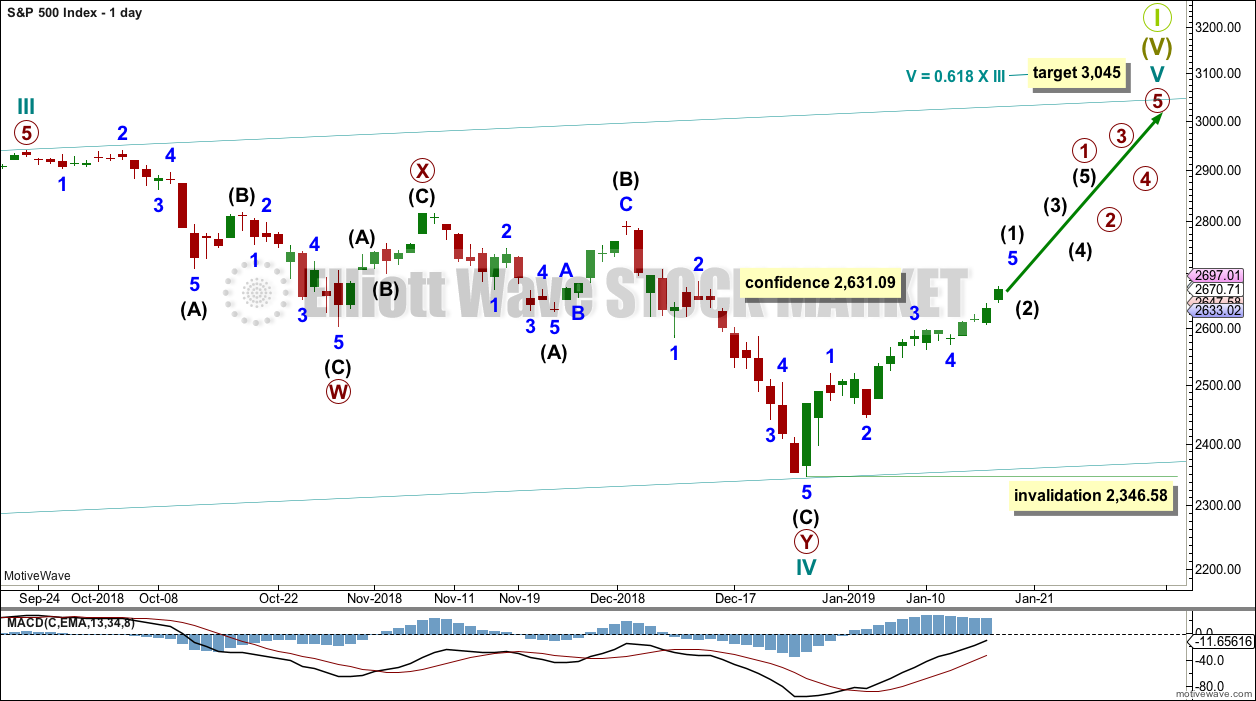


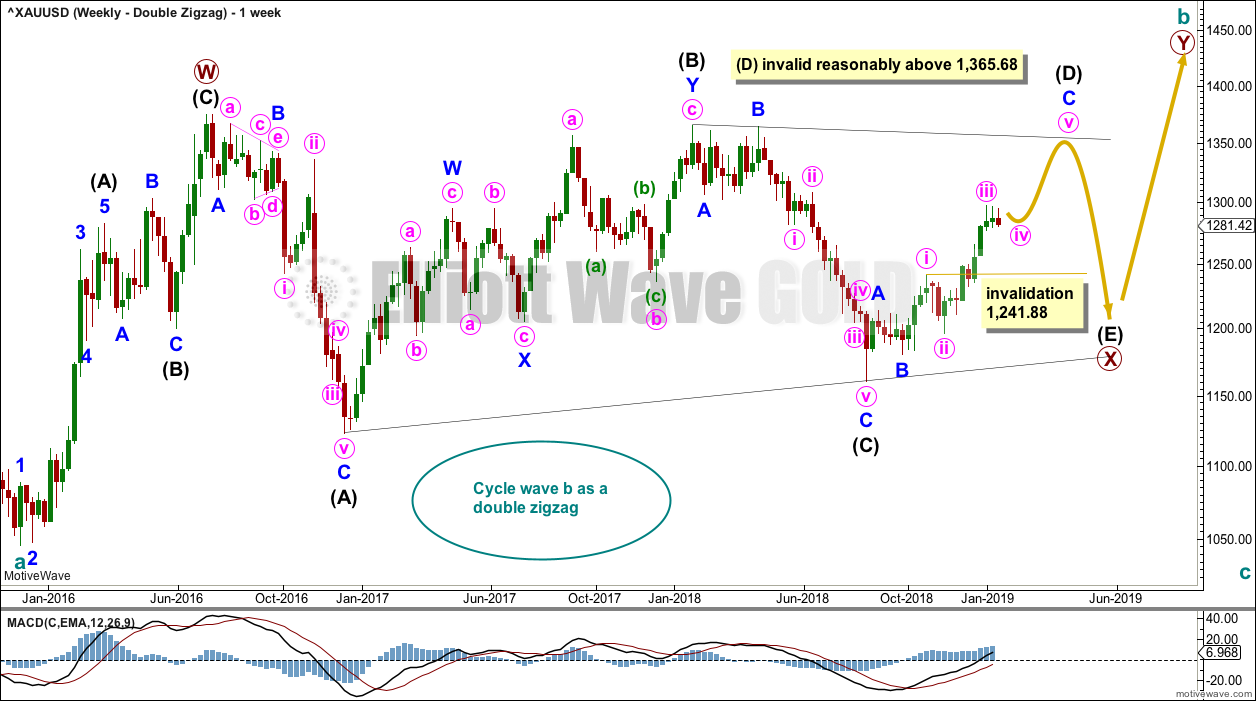
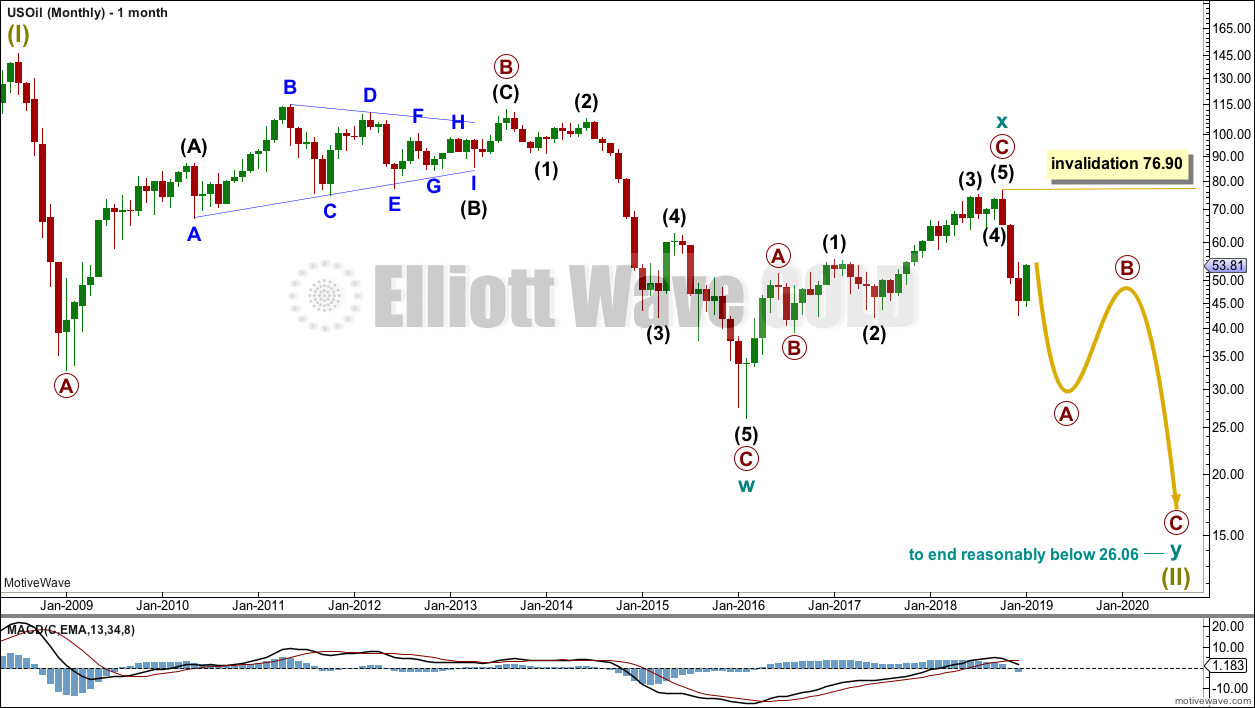
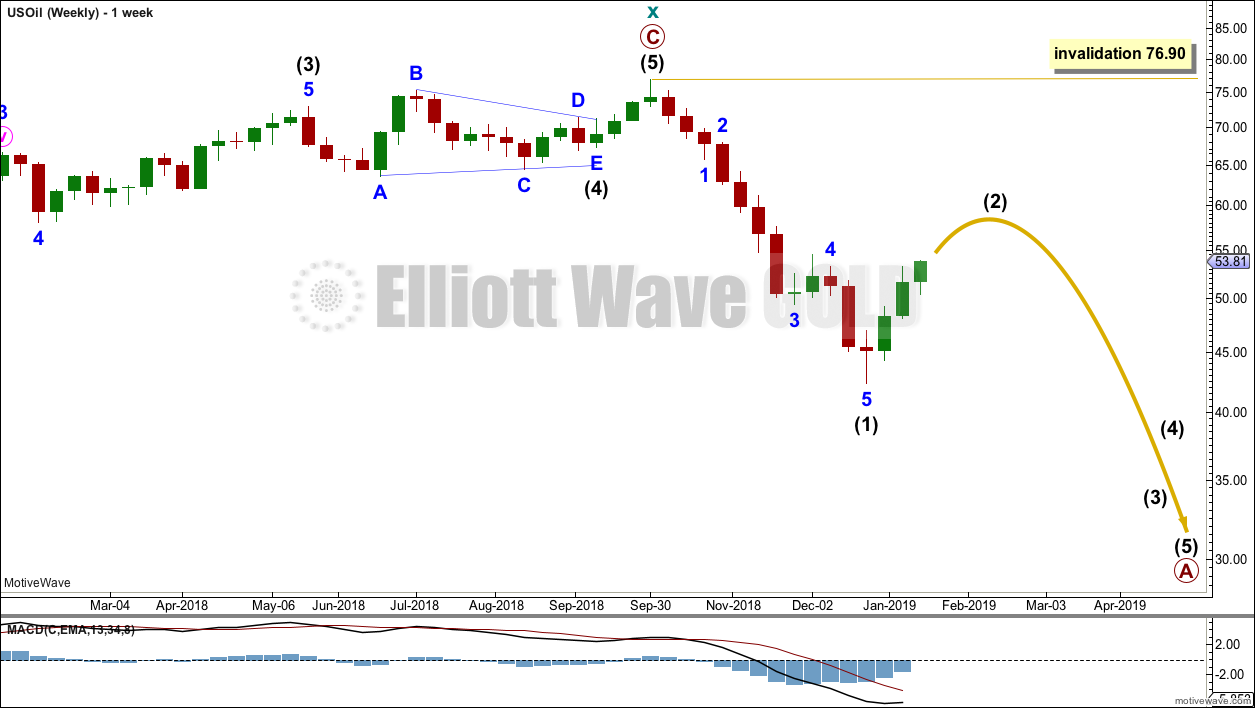
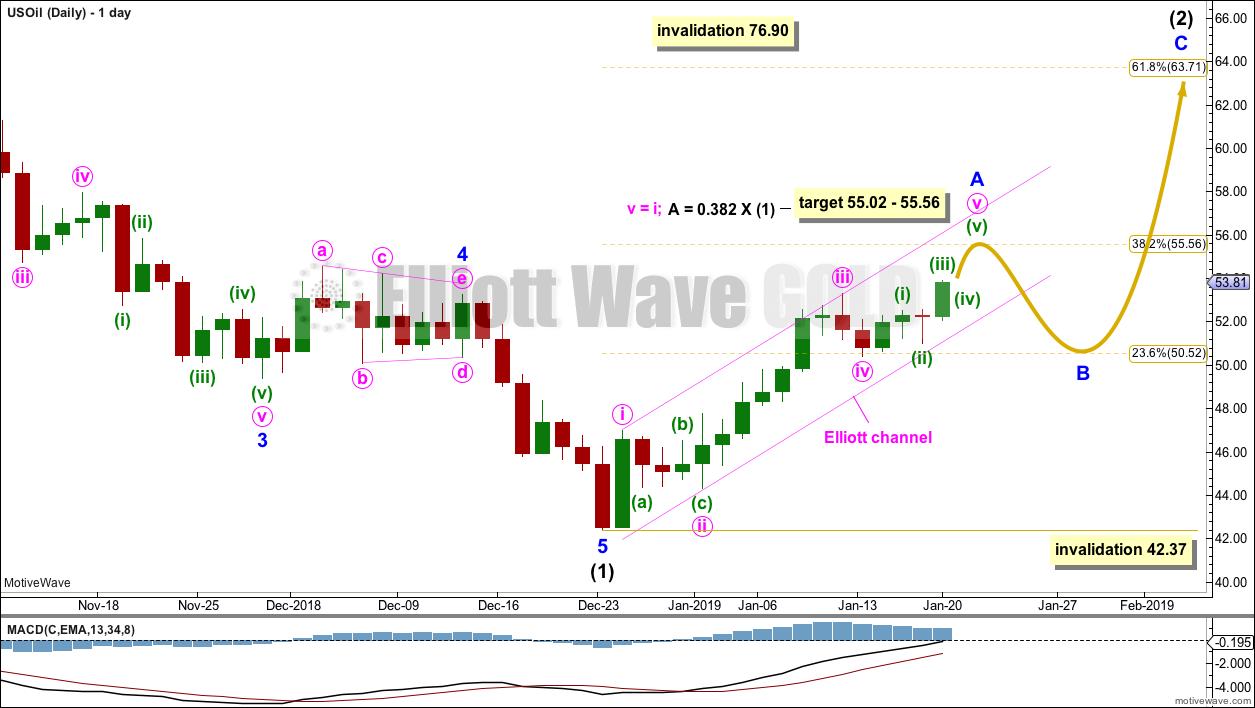
Hi Lara
Can you give us an update mid week, when you feel you can make a judgement. on todays S&P action? Could we have ended intermediate wave 1 or does it look like we have ended minor wave 3 now and starting minor wave 4. Hopefully we’re not seeing the end of primary wave 1 yet although that certainly is possible.
Thanks for your help in advance
Rich
Sure. It looks like intermediate (1) is now over. I could also move the degree of labelling up one, this could be primary wave 1. I won’t know for some weeks yet which degree of labelling is correct.
The difference is material. This could be the first and last big pullback within primary wave 5, or it could be the first of two big pullbacks.
A possible target for intermediate wave (2) would be the 0.618 Fibonacci ratio of intermediate wave (1) at 2,742.
Lara
You said 2742 did you mean 2472?
Oh yes, sorry. 2,472
Hi Lara, off the recent lows could another alternate for the S&P500 be an A-B-C corrective up instead of impulsive, before commencing the down again? Tj
I could force such a count. But it would not have support from classic technical analysis. I’m not prepared to publish such a count if I have no confidence in it.
Also, note how perfectly price has bounced up off the channel. That too is a strong indication that the count should be correct, or at least, the channel is drawn correctly now.
Thanks Lara